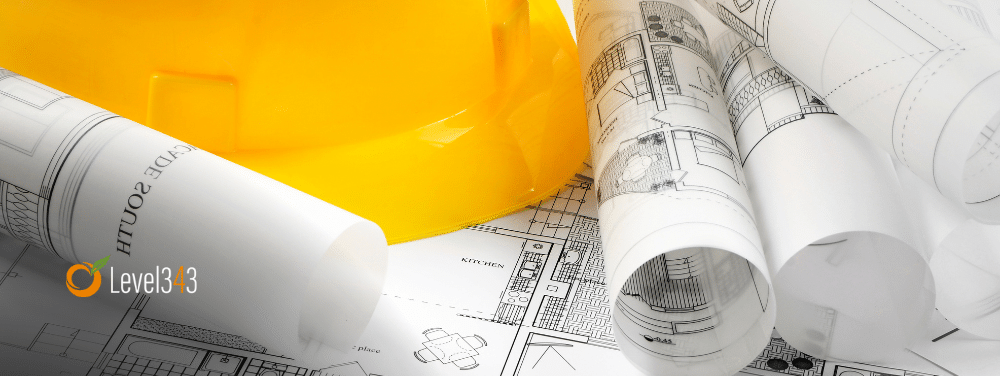What if I told you there was a magic button you could push to increase ranking, traffic, engagement, and conversions? You’d probably tell me to put down the hooch and come back to the land of the sober. Yet, website architecture is just such a “magic” button.
Note that I didn’t say it was the “easy” button. While optimizing your website structure has a powerful effect on a site that has a poor one, online success has never been easy. There are a lot of moving parts, concepts, elements, and best practices to consider.
What is Website Architecture?
Building a website is like constructing a building from the ground up. It requires a solid foundation and thoughtful structure. Website architecture serves as the blueprint for your building. It meticulously maps and organizes the elements and components to create a cohesive, user-friendly, and efficient website.
However, the significance of website architecture extends beyond organization. It’s a crucial factor in optimizing for search engines, making it easier to understand, crawl, and index your content. It also shapes the user experience, influencing how visitors interact with and navigate your digital space.
There’s a lot of planning and maintenance to ensure that users have an enjoyable experience while exploring the website. Your team will learn to organize important information to help users navigate more freely. If they’re on your website, they’re looking for information. By learning what users look for, you can organize your content so they can quickly find what they’re looking for.
Remember, satisfied customers share their experiences. Unhappy customers tend to spread the word even faster. Optimizing your website structure, from the home page to the contact and everything in between, provides the positive user experience they expect.
6 Core Elements of Website Architecture
Website architecture has several core elements essential to creating a functional, user-friendly, and searchable website. These elements provide a solid structure for your site’s design and content. They’re the pillars that support a well-designed website architecture, ensuring it meets the goals of both the business and its users by being discoverable, accessible, and enjoyable to use.
An organized sitemap
A sitemap is a roadmap of all the pages on a website. Both users and search engines need to understand the layout and hierarchy of content on the site. A well-organized sitemap can facilitate better indexing by search engines and improve user navigation.
Most content management systems have their own sitemap creation tools. However, tools like FlowMapp, Slickplan, or MindMeister give you a platform to visually design the structure of your site.
Clean, SEO-friendly URLs
Clean, logical, and SEO-friendly URLs are crucial. A well-structured URL helps users and search engines understand what the page is about before even visiting it.
When creating URLs, they might as well be squeaky clean. They should be pleasing to read and help users to engage. As mentioned, URLs signal what the content of the page looks like. This provides transparency for users and search engines.
Consider the following tips for creating user-friendly URLs:
- Keep it simple. URLs should be easy to read and understand.
- Use relevant keywords. This isn’t necessarily an SEO play. You want to use keywords that reflect the page’s content so users know what to expect on the page.
- Use hyphens to separate words. Underscores are generally used in filters and may be ignored.
- Don’t use special characters. Special characters, such as (+), in your URLs can cause browser issues.
- Use lowercase letters. I can’t count how many times we’ve cleaned up sites with duplicate pages because of variations in capitalization. Some servers treat MyPage as a separate page from mypage, creating problems with your SEO endeavors.
- Be descriptive, but precise. You want to describe the page content, but you don’t want the URL to be miles long.
- Create an intuitive structure. A logical URL hierarchy that follows your navigation and content structure will make more sense to users and search engines.
- Limit category usage. While categories can help you streamline your navigation and provide a clear path, too many categories can make your URL look complicated.
- Don’t use dates. The caveat to this is if your content is news-related or date-specific. Evergreen content shouldn’t include dates, which can make the content seem outdated.
- Be consistent. Once you decide how to lay out your URL structure, stick with it. Maintaining consistency avoids confusion for your users.
Intuitive navigation
Navigation menus guide your visitors through the website. Good navigation should be intuitive and consistent across the entire site, making it easy for users to find what they need without unnecessary clicks.
To ensure visitors can find the information they need, it’s essential to place menus consistently throughout the site, typically at the top or left side of screens, where users expect to find them. Clear labels help users quickly identify the sections they want to explore, whether they’re searching for blog posts, important pages, or pieces of content.
Help improve your navigation with the following tips:
- Provide intuitive navigation to help users find exactly what they’re looking for. Your website will log fewer bounce rates from navigational links, and your SEO results will improve.
- Use easy-to-understand menu labels. For example, having “Social Media Services” for your anchor text is more informative than “Our Offerings.”
- Keep the menus simple and consistent. Make sure drop-down menus are accessible and never difficult to navigate.
- Highlight the current location. Use visual cues like highlights and color changes to indicate what page the visitor is on.
- Make dropdown menus easy to use. Make sure they’re easy to open, easy to use, and don’t disappear too fast.
- Test your navigation with real users. You want to know how real visitors use your menus. Collect feedback and make adjustments based on how easy it is for them to complete tasks.
- Provide a search bar for faster navigation. Never expect your menus to carry the full weight of your site navigation. Having a search bar allows users to quickly navigate to deeper, more informative pages.
An organized content hierarchy
Think of a web page as a chapter in your website’s story. Each web page should be a well-crafted piece of content that captivates your audience, just like a chapter in a good book. The content should be organized logically, making it easy for website visitors to navigate and find what they want. Whether it’s a blog post, a landing page, or a product page, a clear content hierarchy ensures that your website conveys its message effectively.
How do you create a logical and effective content hierarchy?
- Define the purpose of your site. Is your site for sales? Are you developing interest and awareness? Maybe you just want a business card. The purpose makes a difference in how you lay the site out.
- Prioritize your content offerings. It’s a good idea to prioritize based on your target audience’s needs and preferences rather than what you think is important. Put the most important content at the top of your hierarchy.
- Use clear headings. Use descriptive headings and subheadings to reflect what’s on the page and guide users through your site.
- Create a logical flow. Much like water follows the path of least resistance, so should your visitors. Structure your content to lead them from general content to more specific content. Let them decide how deep they want to go down the rabbit hole of knowledge.
- Use visual cues. Size, color, and contrast can create a visual difference between levels, such as larger fonts for main headings.
Whether you’re building a new site or revamping an old one, there are several tools to help you with content organization. Dynomapper, for example, creates a visual inventory of your site, which is helpful for content planning. An AI-driven tool, MarketMuse can help you build a logical content strategy for your site.
Thoughtful internal links
Internal links not only help with website navigation but also connect content, giving users and search engines a clear path through your site. They also help establish an information hierarchy and spread page authority throughout your website.
Rather than link for the sake of internal linking, be thoughtful with your choices:
- Use descriptive text. Use anchor text that describes what they’ll find when they click the link.
- Link to relevant pages on your site at different levels. Internal links should lead to related content. Deep links (links beyond the home, contact, and service pages) should highlight more substantial, interesting content within your site.
- Link within the body of the content. Search engines are smart enough to recognize a menu link compared to a link within the content. Whenever possible, link within the content rather than in footers and menus.
- Create content hubs or topic clusters. Content hubs, pillar pages, topic clusters, and categories all provide access to a broad topic. Cluster pages and posts under these hubs that cover related, specific topics, then link back to the pillar page and each other. For example, if you’re linking from a blog post, you might link to the related category page, as well as another post within the same category.
- Don’t link for the sake of linking. Make sure the links you’re including provide value. Linking just to be linking can reduce the user experience by pulling visitors into another information hunt.
One of our favorite tools for finding relevant internal links is Screaming Frog SEO Spider. Screaming Frog is a powerful tool for SEO and content audits, but it also provides an easy way to locate appropriate pages deep within your site.
A responsive web design
With so many people using their mobile devices for search, it’s only logical to design a website layout that can adapt to different devices and screen sizes. Responsive web design helps ensure that user experiences remain consistent across every platform. As you gain understanding, it’s easy to see why responsive web design is so important in today’s digital world. A non-responsive website will appear in far fewer search results.
Several actions can help you achieve your responsive design goals. Optimize your content and your media. Pages will load faster by compressing images and videos, and by all means, make sure your users can play your multimedia content on their mobile devices.
As in everything related to your website, provide clear and interesting content with font sizes people can read. Space paragraphs to make content readable on smaller screens.
Responsive Web Design Checker and BrowserStack let you check your website to see how well it performs in this area.
Wrapping it up
Developing a strong website architecture is like putting together a complex puzzle. It requires a detailed approach to organizing and planning your online business. Your overall goal in this endeavor is to create a user-friendly environment where visitors can navigate effortlessly, find the content they seek promptly, and have an experience so seamless that it feels intuitive.
This guide serves as your starting point. Remember, there’s no one-size-fits-all approach to website architecture, and the most successful sites are those that continuously evolve and adapt to the needs of their users.
By pressing the “magic” button of website architecture, you’re committing to an ongoing process of refinement and improvement. It’s a path that demands attention to detail, a deep understanding of your audience, and a dedication to providing value at every click. There may not be an “easy” button, but the rewards of a well-structured website are worth every effort. The digital landscape awaits—plan, build, and navigate wisely.



































